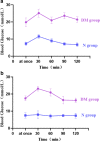The disappearance of IPO in myocardium of diabetes mellitus rats is associated with the increase of succinate dehydrogenase-flavin protein
- PMID: 33731005
- PMCID: PMC7968298
- DOI: 10.1186/s12872-021-01949-z
The disappearance of IPO in myocardium of diabetes mellitus rats is associated with the increase of succinate dehydrogenase-flavin protein
Abstract
Background: The aim of the present study was to investigate whether the disappearance of ischemic post-processing (IPO) in the myocardium of diabetes mellitus (DM) is associated with the increase of succinate dehydrogenase-flavin protein (SDHA).
Methods: A total of 50 Sprague Dawley rats, weighing 300-400 g, were divided into 5 groups according to the random number table method, each with 10 rats. After DM rats were fed a high-fat and -sugar diet for 4 weeks, they were injected with Streptozotocin to establish the diabetic rat model. Normal rats were fed the same regular diet for the same number of weeks. Next, the above rats were taken to establish a cardiopulmonary bypass (CPB) model. Intraperitoneal glucose tolerance test (IPGTT) and oral glucose tolerance test (OGTT) were used to detect whether the DM rat model was established successfully. Taking blood from the femoral artery to collect the blood-gas analysis indicators, and judged whether the CPB model is established. After perfusion was performed according to the experimental strategy, the area of myocardial infarction (MI), and serum creatine kinase isoenzyme (CK-MB) and cardiac troponin (CTnI) levels were measured. Finally, the relative mRNA and protein expression of SDHA was detected.
Results: The OGTT and IPGTT suggested that the DM rat model was successfully established. The arterial blood gas analysis indicated that the CPB model was successfully established. As compared with the N group, the heart function of the IR group was significantly reduced, the levels of myocardial enzyme markers, the area of MI, as well as the relative mRNA and protein expression of SDHA, were all increased. As compared with the IR group, the CK-MB and CTnI levels in the IPO group, the MI area, relative mRNA and protein expression of SDHA decreased. As compared with the IPO group, the myocardial enzyme content in the DM + IPO group, the MI area and the relative mRNA and protein expression of SDHA increased. As compared with the DM + IPO group, in the DM + IPO + dme group, the myocardial enzyme content, area of MI and relative mRNA and protein expression were all decreased.
Conclusion: IPO can inhibit the expression of SDHA, reduce MIRI and exert a cardioprotective effect in the normal rats. However, the protective effect of IPO disappears in the diabetic rats. The inhibitor dme combined with IPO can increase the expression of SDHA and restore the protective effect of IPO in DM myocardia.
Conflict of interest statement
The authors declare that they have no competing interests.
Figures








Similar articles
-
Effect of Ischemic Postconditioning on Myocardial Function and Infarct Size Following Reperfusion Injury in Diabetic Rats Pretreated With Vildagliptin.J Cardiovasc Pharmacol Ther. 2018 Mar;23(2):174-183. doi: 10.1177/1074248417729881. Epub 2017 Sep 13. J Cardiovasc Pharmacol Ther. 2018. PMID: 28901167
-
Diabetes impairs the protective effects of sevoflurane postconditioning in the myocardium subjected to ischemia/ reperfusion injury in rats: important role of Drp1.BMC Cardiovasc Disord. 2021 Feb 16;21(1):96. doi: 10.1186/s12872-021-01906-w. BMC Cardiovasc Disord. 2021. PMID: 33593294 Free PMC article.
-
Inhibitors of soluble epoxide hydrolase minimize ischemia-reperfusion-induced cardiac damage in normal, hypertensive, and diabetic rats.Cardiovasc Ther. 2017 Jun;35(3):10.1111/1755-5922.12259. doi: 10.1111/1755-5922.12259. Cardiovasc Ther. 2017. PMID: 28296232 Free PMC article.
-
Reduction of SIRT1 blunts the protective effects of ischemic post-conditioning in diabetic mice by impairing the Akt signaling pathway.Biochim Biophys Acta Mol Basis Dis. 2019 Jun 1;1865(6):1677-1689. doi: 10.1016/j.bbadis.2019.04.005. Epub 2019 Apr 4. Biochim Biophys Acta Mol Basis Dis. 2019. PMID: 30954556
-
Effects of endomorphin-1 postconditioning on myocardial ischemia/reperfusion injury and myocardial cell apoptosis in a rat model.Mol Med Rep. 2016 Oct;14(4):3992-8. doi: 10.3892/mmr.2016.5695. Epub 2016 Aug 31. Mol Med Rep. 2016. PMID: 27600942
References
Publication types
MeSH terms
Substances
LinkOut - more resources
Full Text Sources
Other Literature Sources
Medical
Research Materials
Miscellaneous

